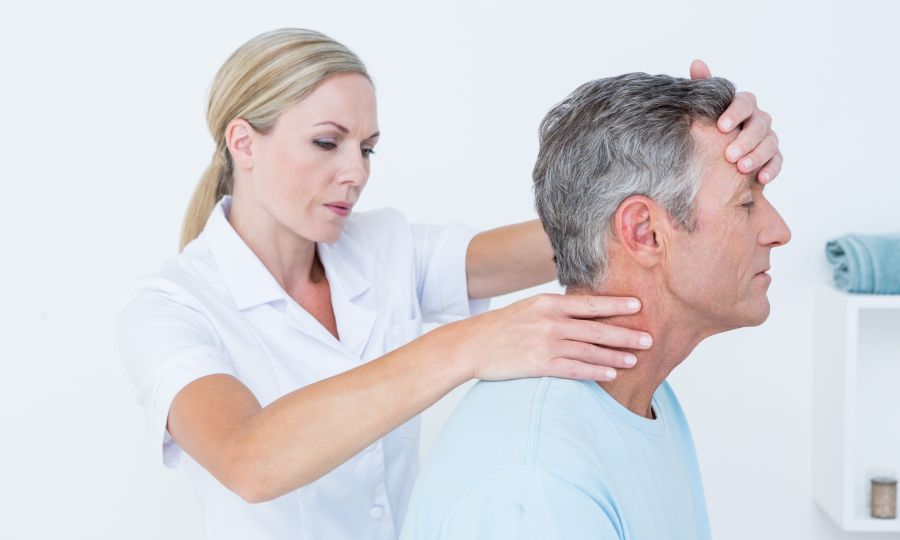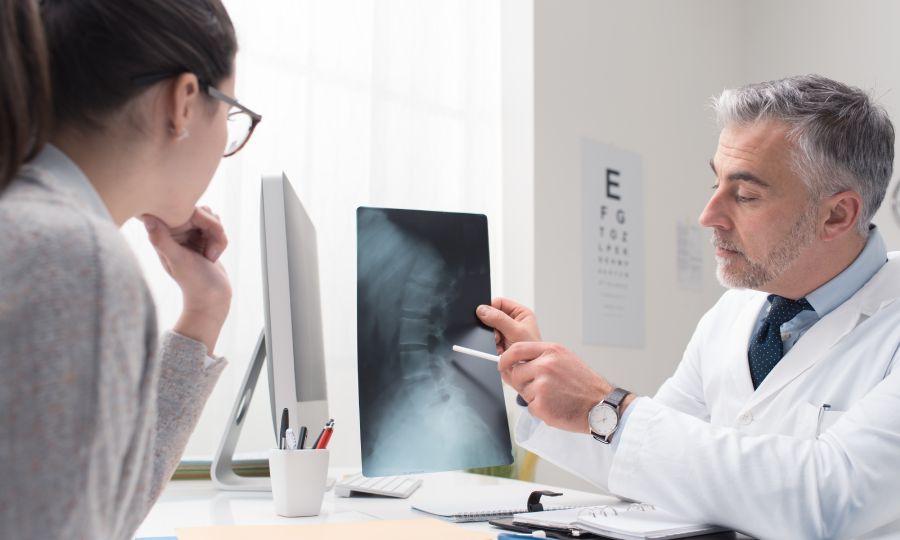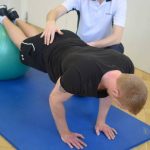You’ve just undergone surgery on your cervical spine, and you feel like you’re facing a mountain that needs to be overcome. Pain, limited movement, uncertainty about what to do next, cause fear and indecision. Remember: your feelings are a common occurrence after such surgery. But there is a path to recovery, and it begins with understanding the rehabilitation process.
What is the rehabilitation after surgery on the cervical spine
Rehabilitation after surgery on the cervical spine is a set of medical and physical measures aimed at restoring the functionality of the neck and the patient’s quality of life.
Importance of rehabilitation in the recovery process
Rehabilitation after surgery on the cervical spine plays a vital role in restoring the patient’s physical function and quality of life. Various methods and techniques aimed at restoring mobility, strength, and control of the muscles of the cervical spine are actively used in this process.
When taking rehabilitation measures, individual characteristics of the body, the degree of disease development, and the patient’s general health condition are primarily taken into account. During the rehabilitation course, it is important to select correctly the level of loads to avoid overexertion and not provoke a repeated deterioration of the condition.
A carefully planned and systematic rehabilitation allows achieving the following goals:
- Restoring the patient’s physical activity.
- Improving muscle and joint function.
- Restoring normal blood circulation in the area of the surgical operation.
- Improving the patient’s overall well-being and quality of life.
Rehabilitation also contributes to improving the patient’s psychological condition, as active participation in the recovery process helps to increase self-esteem and confidence in their abilities.
It is important to understand that rehabilitation is not just recovery after surgery, it is an intensive process aimed at improving the patient’s quality of life, his return to full social and professional activities.
Postoperative period

Features of the postoperative period
The postoperative period after surgery on the cervical spine is a time of active body recovery and adaptation to new conditions. During this period, it is important to carefully monitor your condition and respond to any changes.
The first days after the surgery are a time period when it is important to prevent complications. This may include pain in the neck area, headaches, dizziness, weakness in the arms or legs, problems with coordination of movements. Therefore, it is necessary to carefully monitor your condition and immediately report all observed symptoms to the doctor.
Immediately after the surgery, the patient may experience some weakness and discomfort in the neck area. This is normal and usually subsides within a few days or weeks. However, analgesics may be prescribed to alleviate pain.
The first weeks after the surgery usually require caution in movements and physical activity. The patient may be recommended to wear an orthopedic collar to support the neck. This helps reduce the load on the operated area and promotes better healing.
Diet and rest play an important role in the postoperative period. Protein food, rich in vitamins and minerals, promotes quick recovery of the body. In addition, a sufficient amount of sleep and rest helps the body cope with the load related to the surgery.
As time goes by and under the supervision of doctors, the stage of active rehabilitation begins. Training sessions with a physiotherapist begin, exercises are introduced to restore neck muscles and improve joint mobility. However, it’s important to remember that every person is individual, and the speed of recovery can vary significantly.
In general, the postoperative period requires patience, careful adherence to the doctor’s recommendations, and attention to one’s condition. But with the right correct approach and perseverance, full recovery is quite achievable.
Necessary medical procedures
Immediately after surgery on the cervical spine, doctors may undertake a number of medical measures to support the patient and facilitate recovery.
- Pain control: One of the most important aspects of postoperative care is managing the pain syndrome. Medical staff may use a combination of drugs to control pain, including local anesthetics, nonsteroidal anti-inflammatory drugs (NSAIDs), as well as stronger drugs if necessary.
- Maintaining mobility: An important aspect of early rehabilitation is maintaining mobility. Doctors and physiotherapists may start with simple exercises to prevent stiffness and loss of muscle tone.
- Physiotherapy: A course of physiotherapy, including exercises to improve mobility, strengthen muscles, and improve overall physical fitness, can begin immediately after the surgery. Physiotherapy can also include techniques such as heat therapy and massage to reduce pain and improve circulation.
- Medical support: Medical staff will regularly carry out checks to ensure that the recovery process is progressing normally. This may include general checks, as well as special tests, such as MRI or X-ray to assess the condition of the spine.
- Psychological support: The recovery period after the surgery can be stressful for many patients. Psychological support, including consultations with a psychologist or psychiatrist, can be helpful to ease this period.
Despite the fact that every patient and every case is unique, these medical measures represent a general care scheme that one can expect after the surgery on the cervical spine.
Main Stages of Rehabilitation

Early Stage of Rehabilitation
The early stage of rehabilitation begins immediately after the surgery and continues until the patient can return home and continue the recovery process independently. The duration of this stage depends on the complexity of the surgical operation and the individual condition of the patient.
- Mobilization: One of the first tasks at this stage is early mobilization. Doctors and physiotherapists will help the patient to get up and start moving as soon as possible after surgery. This helps prevent problems related to a prolonged bed rest, such as thrombosis and bedsores.
- Pain Management Therapy: Pain management is essential in the early stage of rehabilitation. Adequate pain relief treatment allows the patient to participate in physical rehabilitation and improves their quality of life.
- Physiotherapy: Exercises under the supervision of a physiotherapist begin in the early stage of rehabilitation. This may include simple exercises to maintain neck and shoulder girdle mobility, as well as more complex exercises to strengthen the neck and upper back muscles.
- Working with Specific Symptoms: Depending on the nature of the surgical operation and the condition of the patient, certain problems may arise that need to be addressed in the early stage of rehabilitation. This may include problems with the back, dizziness, chest pain, or swallowing difficulties.
- Emotional Support: In the early stage of rehabilitation, it is important to provide the patient with emotional support. Surgery on the cervical spine can cause anxiety and stress, and the emotional state can affect recovery. Psychological help can be very useful.
The early stage of rehabilitation is a critically important stage of recovery after surgery on the cervical spine. This is a time when the medical team focuses on reducing pain, restoring basic mobility, and supporting the patient in a difficult time.
Late Stage of Rehabilitation
The late stage of rehabilitation begins when the patient returns home after inpatient treatment. This is a time of active recovery and return to normal life. During this period, work on physical strength, flexibility, pain management, and support of the psychological state becomes important.
- Physical Therapy: Regular physiotherapy sessions become important in the late stage of rehabilitation. The exercises will include work on strength, flexibility, balance, and coordination. The physiotherapist can also give recommendations for pain relief, for example, taking analgesics or applying relaxation techniques.
- Pain Management: In the late stage, the struggle against pain continues, but the focus may shift to long-term pain management. This may include lifestyle changes, the use of certain medications, and the use of alternative pain management methods.
- Maintaining a Healthy Lifestyle: A healthy lifestyle plays a key role in recovery after surgery and in preventing further health problems. This includes a balanced diet, regular exercise, quitting smoking, and managing stress.
- Return to Everyday Life: The late stage of rehabilitation includes preparation for returning to work, household chores, and social life. It may be helpful to discuss with your doctor and physiotherapist what activities and exercises are safe to perform, and which ones should be avoided.
- Psychological Support: Psychological support continues in the late stage of rehabilitation. It may be helpful to discuss any fears or problems with a psychologist or counselor.
The late stage of rehabilitation is a key time for patient recovery after surgery on the cervical spine. This is a time when it’s important to pay attention not only to physical, but also emotional recovery.
Diet and Rest Regime After Cervical Spine Surgery

Diet Regime
Rehabilitation after surgery on the cervical spine requires not only physical efforts, but also support for the correct diet regime. Balanced nutrition helps the body recover from surgical intervention, supports the immune system, and improves overall general health. Here is a list of main foods and their importance for the rehabilitation process:
- Proteins: Help in tissue recovery and muscle strengthening. Sources: meat, fish, dairy products, beans, nuts.
- Complex carbohydrates: Provide energy for physical activity and general body recovery. Sources: whole grain breads, cereal porridges, legumes, vegetables.
- Healthy fats: Support normal metabolism and improve nervous system function. Sources: avocado, nuts, seeds, fish, olive oil.
- Vitamins and minerals: Support the immune system and help in tissue recovery. Calcium and vitamin D are particularly important for bone health. Sources: fruits, vegetables, dairy products.
- Water: Hydration is important for all processes in the body, including recovery.
Rest Regime
During rehabilitation, it is also important to follow a rest regime. Adequate sleep helps in recovery and improving overall health condition. You should aim to get at least 7-9 hours of quality sleep each night. Daytime rest and short naps can also help to recover energy during the day.
It’s also necessary to consider that after surgery on the cervical spine, a special approach to sleeping position might be required to minimize discomfort and maintain the proper position of the neck.
Video: “Rehabilitation after surgery on the cervical spine”
SET OF EXERCISES №1 FOR THE CERVICAL SPINE. INITIAL STAGE OF RECOVERY
For additional information about the recovery process after surgery on the cervical spine, you can watch a video demonstrating exercises and rehabilitation recommendations.
Physical Rehabilitation

Features of Physical Rehabilitation After Surgery
After surgery on the cervical spine, physical rehabilitation should be not intensive but consistent. It’s important to take into account the individual characteristics of each patient, their health condition, and recovery dynamics.
Types of Exercises and Their Importance
Neck exercises after surgery include stretching exercises, muscle strengthening exercises, and aerobic exercises. A combined approach helps to accelerate recovery, improve mobility, and reduce pain intensity.
Tips for Everyday Life
During the recovery period, it’s important to maintain a healthy lifestyle, keep your diet, and take time to rest. Pay attention to your body’s position during sleep and rest, to prevent additional strain on the cervical spine.
Physical Load
In this section, we provide a description of the main exercises for recovery after surgery on the cervical spine. They should be performed under the supervision of a specialist or after their consultation.
Diagonal Neck Stretch: Upwards
Sitting upright, slowly tilt your head to the left so that your right ear approaches your right shoulder. Then slowly raise your head up and to the right, returning to the starting position. Repeat the exercise for the other side.
Diagonal Neck Stretch: Downwards
Repeat the previous exercise, but instead of raising your head upwards, lower it downwards, as if trying to touch the shoulder with your chin.
Lateral Neck Stretch
Sitting upright, slowly tilt your head to the left so that your left ear approaches your left shoulder. Hold the position for 15-30 seconds, then return to the starting position and repeat the exercise for the right side.
Chest Stretch in the Door Frame
Place both hands on the edges of the door frame at chest level. Slowly increase the load, straightening your arms and arching your back.
Chin Tuck
Sitting upright, smoothly tuck your chin in, trying to create a “double chin”. Hold this position for about 5 seconds, then relax.
Jaw Drop
Sitting upright, slowly drop your jaw down as if yawning. Hold the position for about 5 seconds, then return to the starting position.
Shoulder Rolls Backwards
Sitting upright, perform rotational movements with your shoulders backwards.
Circular Arm Movements
Raise your arms and perform slow circular movements, starting with small circles and gradually increasing their diameter.
Retracting Arms and Shoulders Backwards
Sitting upright, slowly retract your arms and shoulders backwards, trying to bring your shoulder blades as close together as possible.
Diaphragmatic Breathing
Sitting or lying down, take a deep breath through your nose, filling not only your chest but also your stomach with air. Exhale through your mouth, completely emptying your lungs.
Medication Support

Necessary Medications and Their Action
There are several medications that are often used in the process of rehabilitation after surgery on the cervical spine. Each of them plays its own role in the recovery process.
- Non-steroidal anti-inflammatory drugs (NSAIDs): They include drugs such as ibuprofen (Nurofen) or diclofenac (Voltaren). NSAIDs relieve pain and reduce inflammation, thus helping to improve motor activity and patient comfort.
- Muscle relaxants: These are drugs for relieving muscle spasm. Examples are baclofen (Baclosan) and tizanidine (Sirdalud). They help to reduce muscle tension and spasm, which promotes better mobility and comfort.
- Opioid analgesics: In cases of severe pain, opioid analgesics such as tramadol (Tramal) or oxycodone (Oxicontin) may be used. They provide a potent analgesic action but can cause drowsiness and have a risk of developing dependence.
- Drugs for sleep and anxiety: For example, alprazolam (Xanax) or clonazepam (Rivotril) may be useful for managing anxiety or insomnia, which may accompany the recovery process.
- Vitamins and minerals: This includes drugs such as calcium, vitamin D, and magnesium, which support the health of bones and muscles. For example, Calciemin, Complivit Calcium D3, Magne B6 etc.
- Drugs for supporting the nervous system, such as vitamin B complex (Complivit, Multi-tabs) and drugs containing gamma-aminobutyric acid (GABA, for example, Picamilon), can also be used to improve nerve transmission and stimulate recovery.
The selection of the optimal drug therapy should be individualized and based on the patient’s condition, intensity of pain, and other factors. Always consult a doctor before starting any medication therapy.
Possible Side Effects
Any drug used in the process of rehabilitation after surgery on the cervical spine can have side effects. This is important to consider when selecting and taking medications.
Non-steroidal anti-inflammatory drugs (NSAIDs), such as ibuprofen or diclofenac, are usually used to relieve pain and inflammation. However, they can cause gastric problems, including ulcers and bleeding, especially with prolonged use. They can also affect kidney function and cause high blood pressure.
Muscle relaxant drugs, such as baclofen or tizanidine, can cause fatigue, dizziness, and dry mouth. Rarely, more serious side effects can be observed, including liver problems.
Opioid analgesics, such as tramadol or oxycodone, are often used to manage severe pain, but they have a risk of developing dependence and can cause constipation, nausea, slowed breathing, and drowsiness.
Sleep and anxiety medications, such as alprazolam or clonazepam, can cause drowsiness, coordination difficulties, and risk of dependence with long-term use.
It’s important to remember that each individual is unique and may respond differently to medications. All of these issues need to be discussed with the treating physician to determine the most suitable and safe therapy. Side effects should be monitored and reported to the doctor if they occur.
Possible complications
Complications after surgery on the cervical spine can vary and depend on a number of factors, including the patient’s general health, type of surgery, presence of coexisting diseases, etc.
Medical complications
- Infection: This is one of the most common complications of any surgery. Infections in the area of surgical intervention or the site of implant placement are particularly dangerous. Symptoms may include redness, swelling, tenderness in the wound area, fever.
- Nerve damage: During surgery, there is a risk of damage to nerve structures, which can lead to the impaired limb function, decreased sensitivity, or pain.
- Thromboembolic complications: Prolonged bed rest increases the risk of developing clots in the deep veins (deep vein thrombosis), which can break off and cause life-threatening pulmonary artery embolism.
- Implant issues: If implants were used during surgery, there is a risk of their displacement, damage, or rejection.
Rehabilitation Complications
Rehabilitation can also be accompanied by certain difficulties or complications:
- Chronic pain: In some cases, pain may persist even after successful surgical intervention and rehabilitation.
- Impaired limb function: This can occur due to the residual effects of surgery on nerves and muscles.
- Difficulties returning to normal life: Some patients may experience problems returning to work, managing household chores, or participating in social life due to the limited range of motion, chronic pain, or other complications.
- Psychological problems: Anxiety, depression, and stress can arise during recovery. This can negatively impact the progress of rehabilitation and quality of life.
It’s important to remember that the presence of possible complications is not a reason to refuse surgery. Most complications can be prevented or successfully treated. It’s important to pay close attention to your condition and report any problems to your doctor in a timely manner.
Conclusion
Rehabilitation after surgery on the cervical spine is a necessary and important process. Despite possible difficulties and complications, it plays a decisive role in restoring the functions of the cervical spine, improving the patient’s quality of life and returning them to normal life. By adhering to the doctor’s recommendations, performing necessary exercises and maintaining a positive attitude, you can achieve optimal results.
After successful completion of the rehabilitation process, it’s very important to continue maintaining your health and leading an active lifestyle. This will help prevent the recurrence of problems with the cervical spine and contribute to overall well-being.
We advise you to watch the video exercises for restoring the cervical spine on our website. This video will help you better understand how to perform exercises properly and provide additional motivation to continue working on your recovery. Remember, your health is in your hands!
Check out the demo version of our sets of exercises for Cervical spine on YouTube.
You can find more information about Cervical spine problems and rehabilitation in our Library of Articles.
Our website presents sets of exercises for the cervical spine problems in the following areas:
SET OF EXERCISES №1 FOR THE CERVICAL SPINE. INITIAL STAGE OF RECOVERY
SET OF EXERCISES №2 FOR THE CERVICAL SPINE. MID STAGE OF RECOVERY
SET OF EXERCISES №3 FOR THE CERVICAL SPINE. ADVANCED STAGE OF REHAB
FAQs
1. What other types of surgeries may require rehabilitation?
Almost any surgery, including those related to the spine, requires subsequent rehabilitation. This can include surgeries on the thoracic or lumbar spine, orthopedic surgeries (such as joint replacements), cardiac surgeries, neurosurgical procedures, and many others. Each type of surgery will have its own rehabilitation requirements, and therefore a specialized rehabilitation program will be needed.
2. What alternatives to surgical treatment exist for problems with the cervical spine?
Alternatives to surgical treatment depend on the specific condition and may include physical therapy, exercises, the use of braces or corsets, medications (including analgesics and anti-inflammatory drugs), spinal manipulations, and injections (for example, blockades). In some cases, neuromodulation or acupuncture may also be considered. The decision on the most suitable approach is based on the patient’s condition and is made together with the doctor.
3. What professionals are involved in the rehabilitation process?
The rehabilitation process usually involves a healthcare team, which can consist of a physiotherapist, rehabilitation physician, orthopedic doctor, nurse, psychologist, dietitian, and other specialists as necessary. Each professional plays their role in providing a comprehensive approach to the patient’s recovery. The team will work together to develop and implement a rehabilitation plan that will meet the individual needs of the patient.



